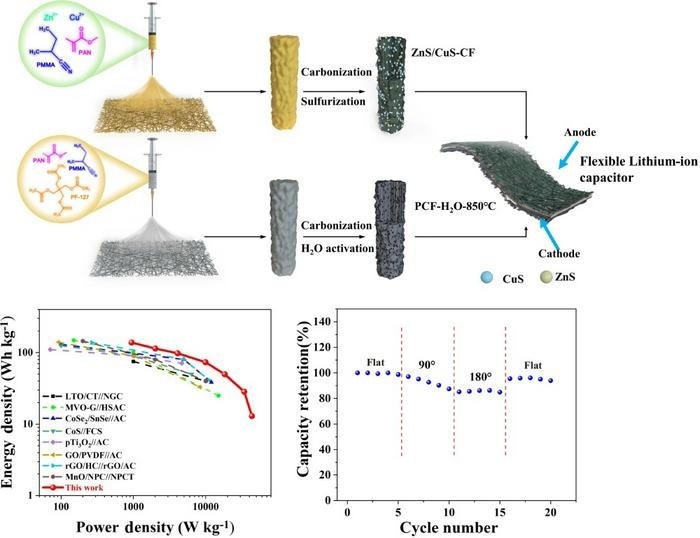When used in the design of flexible lithium-ion capacitors, dual metal sulfides-ZnS/CuS show a noticeable improvement in electrochemical stability and performance over transition metal sulfides and carbon fiber materials.
 The top image shows the construction of the ZnS/CuS anode and carbon fiber cathode used in the experiment. The bottom image illustrates the performance of the ZnS/CuS anode/cathode construction compared to other lithium-ion capacitor functions. Image Credit: Zheng-Hong Huang, Tsinghua University
The top image shows the construction of the ZnS/CuS anode and carbon fiber cathode used in the experiment. The bottom image illustrates the performance of the ZnS/CuS anode/cathode construction compared to other lithium-ion capacitor functions. Image Credit: Zheng-Hong Huang, Tsinghua University
When it comes to flexible lithium-ion capacitors (FLICs), transition metal sulfide (TMS) materials are a common choice for anodes. However, in practical applications, the materials fall short of the theoretical promises. By creating zinc-sulfide nanoparticles that can be incorporated into multichannel carbon fibers (CFs) to improve FLIC performance, researchers hope to change that.
The results were published in Energy Materials and Devices on December 13th, 2023.
To overcome the shortcomings of conventional powder electrodes, researchers used a technique called solution blow spinning, which yields fiber sheets with a high porosity and a large surface area. This was followed by sulfidation, which incorporates sulfide ions into the material.
Multichannel carbon fibers with embedded ZnS/CuS nanoparticles are the end product. This material demonstrated enhanced high specific capacity and rate capacity, along with decreased resistance to charge transfer and ion diffusion. Improvements in energy and power densities were achieved by combining mixed metal sulfides with a FLIC.
An effective strategy to enhance the energy and power densities of CF-based anode materials involves coupling them with highly active materials.
Bohan Li, Researcher and Author, Tsinghua University Press
Combining metals like zinc with sulfides and carbon fibers seems to be a successful way to create a high-capacity anode. The metals can react more quickly due to the high activity level, a major improvement over FLICs.
The carbon fiber network’s structure not only enhances the material’s performance but also lessens the possibility of nanoparticles bunching up, preserving stability and cycle consistency.
Carbon fibers function as a conductive network and 3D matrix, accommodating volume expansion and maximizing the high-capacity feature of ZnS and CuS nanoparticles. This enhances the specific capacity and cycle stability of CF-based anode materials.
Bohan Li, Researcher and Author, Tsinghua University Press
The three-dimensional matrix of the carbon fibers also limits the expansion of ZnS and CuS. At best, an expansion of the battery’s internal components may result in a reduction in performance, and at worst, the battery may completely fail.
A pouch cell was used to test the technology’s usability under pressure (bending). Pouch cells, which are frequently found in laptops, cell phones, and cars, are essentially an enclosed anode and cathode with a separator and conducting material.
The outcomes demonstrate the technology’s versatility, as an LED was successfully lit up at all angles when bent at different angles. The technology not only resisted initial bending, but it also effortlessly assumed its original shape - a crucial feature of flexible technology.
The material intends to advance current technology to increase the range of intelligent, adaptable gadgets that are becoming more and more popular. Advances in these electronics may result in more environmentally friendly technology accessible to both businesses and consumers.
For ZnS/CuS nanoparticle production on a continuous carbon fiber network to be a technology that can be utilized in wearable and portable devices instead of the standard TMSs used in FLICs, it would need to be scaled up.
Contributors to this study included Chenhui Luan from the School of Chemical and Environmental Engineering at China University of Mining and Technology, Bohan Li, Chong Wang, Zhouyang Qin, Changzhen Zhan, Liangliang Li, Wanci Shen, and Zheng-Hong Huang of the Key Laboratory of Advanced Materials at Tsinghua University, along with Ruitao Lv and Zheng-Hong Huang of the State Key Laboratory of New Ceramics and Fine Processing at Tsinghua University.
The National Natural Science Foundation of China and the Inner Mongolia Autonomous Region Major Science and Technology Project funded the study.
Journal Reference:
Li, B., et al. (2024) ZnS/CuS nanoparticles encapsulated in multichannel carbon fibers as high-performance anode materials for flexible Li-ion capacitors. SciOpen. doi.org/10.26599/EMD.2023.9370012